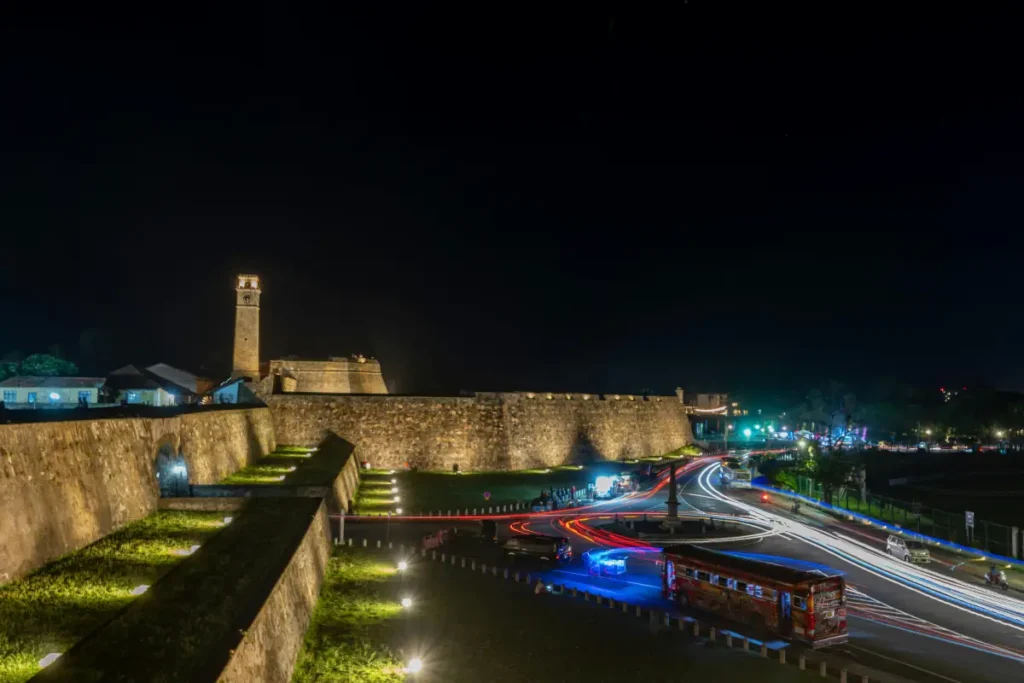
Galle The Historic Gem of Sri Lanka
Galle, located on the southwestern coast of Sri Lanka, represents one of the island nation’s most compelling destinations. This coastal city seamlessly blends colonial heritage, natural beauty, and vibrant local culture, creating an atmosphere that captivates visitors from around the world. From its UNESCO-protected fort to its stunning beaches and rich cultural tapestry, Galle offers a multifaceted experience that reveals Sri Lanka’s complex history and contemporary charm.
A Port City with a Storied Past
Galle’s history as a significant port dates back over a millennium. Arab traders were among the first to discover its strategic location, establishing it as a crucial stop on Indian Ocean trade routes. The city’s name itself likely derives from the Sinhalese word “Galla,” meaning rock, or from the Portuguese word “Gale,” referring to roosters that once adorned the city’s entrance.
While evidence suggests Galle served as a trading hub as early as 125 CE, it was the arrival of the Portuguese in 1505 that marked a turning point in the city’s development. After a storm forced Portuguese ships led by Lourenço de Almeida to seek shelter in Galle’s natural harbor, the Europeans recognized the port’s strategic value and established a small fortification. This initial foothold expanded over decades, transforming Galle into an important colonial outpost.
The Dutch East India Company captured Galle from the Portuguese in 1640, initiating a period of extensive development. The Dutch expanded fortifications, built an elaborate urban grid, and established administrative structures that would shape Galle’s character for centuries. Many of the architectural marvels still standing today date from this Dutch colonial period, including the fort’s impressive ramparts, government buildings, and churches.
British forces took control of Galle in 1796, marking the beginning of the city’s gradual economic decline as a port. The British administration shifted focus to Colombo, diminishing Galle’s prominence as a maritime hub. However, this relative neglect inadvertently preserved much of the city’s Dutch colonial architecture and urban layout, which would later become one of its greatest cultural and touristic assets.
Galle Fort: A Living UNESCO World Heritage Site
The crowning jewel of Galle is undoubtedly its fort, recognized as a UNESCO World Heritage Site in 1988. Unlike many historical monuments that function primarily as museums, Galle Fort remains a living, breathing community where residents go about their daily lives amid centuries-old buildings and fortifications.
The fort encompasses an area of 52 hectares, surrounded by thick stone walls and fourteen bastions that have withstood the test of time—including the devastating 2004 Indian Ocean tsunami, which the fort largely survived intact. This remarkable resilience speaks to the engineering ingenuity of its Dutch builders.
Within the fort’s walls, narrow streets lined with preserved colonial buildings create an atmospheric labyrinth for exploration. The architecture represents a unique fusion of European building traditions adapted to tropical conditions and local design sensibilities. Key structures include:
- The Dutch Reformed Church, built in 1755, with its characteristic gabled roof and elaborate tombstones
- The Maritime Museum, housed in a former Dutch warehouse
- The old Dutch Government House and administrative buildings
- The Clock Tower, added by the British in 1883
- The lighthouse, rebuilt in 1939 after the original structure was destroyed by fire
What makes Galle Fort particularly special is its continued relevance as a living space. Locals operate boutique hotels, cafés, restaurants, and artisan shops within historic buildings that have been thoughtfully adapted for contemporary use. This organic preservation approach has allowed the fort to avoid becoming a sterile museum piece, instead evolving into a vibrant community where history remains palpable without sacrificing modern comfort or functionality.
Beyond the Fort: Natural Beauty and Cultural Riches
While the fort dominates Galle’s identity, the surrounding region offers abundant natural beauty. The coastline features several stunning beaches, including Unawatuna, consistently ranked among the world’s most beautiful beaches. Just a short drive from Galle, Unawatuna offers golden sands, clear waters, and excellent swimming conditions protected by a coral reef.
Other nearby beaches include Jungle Beach, a secluded cove accessible via a short hike through greenery; Dalawella Beach, known for its famous palm tree rope swing; and Wijaya Beach, popular for its natural swimming pools formed by coral formations. These diverse coastal environments provide options for relaxation, water sports, or simply enjoying Sri Lanka’s tropical setting.
The inland areas surrounding Galle showcase Sri Lanka’s lush biodiversity. Hikkadawa River offers opportunities for boat safaris to spot wildlife and explore mangrove ecosystems. The Kanneliya Rainforest, though lesser-known than some of Sri Lanka’s northern nature reserves, provides an excellent opportunity to experience the island’s remarkable biodiversity through guided hiking trails.
Cultural experiences beyond the fort include visits to Buddhist temples, traditional mask carving workshops, and cinnamon plantations that continue Sri Lanka’s centuries-old spice production traditions. The region’s craft heritage remains strong, with local artisans creating handmade lace (a tradition introduced by Portuguese settlers), jewelry, woodcarvings, and textiles using techniques passed down through generations.
Contemporary Galle: A Creative Hub
Modern Galle has emerged as a creative and intellectual center within Sri Lanka. The annual Galle Literary Festival, established in 2007, attracts authors, poets, and thinkers from across South Asia and beyond. This prestigious event has positioned Galle as a cultural hub and highlights Sri Lanka’s literary contributions while fostering cross-cultural dialogue.
The city has also developed a reputation for design and creative industries. Many historical buildings within the fort have been transformed into art galleries, design studios, and boutiques showcasing contemporary Sri Lankan creativity alongside traditional crafts. This artistic renaissance has attracted both international and domestic creative professionals who find inspiration in Galle’s unique atmosphere.
Culinary innovation thrives in Galle as well, with restaurants blending traditional Sri Lankan flavors with international techniques. Seafood naturally dominates local menus, with the daily catch transformed through recipes that reflect the region’s multicultural heritage—incorporating Portuguese, Dutch, British, Arab, Malay, and indigenous influences.
Economic Transformations: Tourism and Development
Galle’s economy has undergone significant transformation in recent decades. While traditional industries like fishing, agriculture, and handicrafts remain important, tourism has emerged as a dominant economic force. The accommodation sector spans from luxury boutique hotels in restored colonial buildings to family-run guesthouses and beachside resorts.
This tourism development has created economic opportunities but also presents challenges for sustainable growth. Local authorities and community organizations work to balance preservation with development, maintaining Galle’s authentic character while improving infrastructure and services. The city has implemented various initiatives to manage tourism impacts, including waste management programs, pedestrianization of certain areas within the fort, and community-based tourism projects that ensure benefits reach local residents.
Cultural Mosaic: Galle’s Diverse Communities
Galle’s population reflects Sri Lanka’s diverse ethnic and religious makeup. Sinhalese Buddhists form the majority, but significant Tamil, Muslim, and Burgher (descendants of European colonists) communities contribute to the city’s multicultural character. This diversity is visible in the religious buildings scattered throughout the area: Buddhist temples, Hindu kovils, mosques, and churches coexist in relative harmony.
The Burgher community, though diminished after many emigrated following Sri Lanka’s independence in 1948, has left a lasting cultural imprint on Galle. Their unique cultural heritage combines European and Sri Lankan influences, evident in architecture, cuisine, and certain linguistic features. Some Burgher families maintain ancestral properties within the fort, providing living connections to this distinctive cultural legacy.
Environmental Challenges and Resilience
Like many coastal regions, Galle faces environmental challenges related to climate change, including erosion, extreme weather events, and rising sea levels. The 2004 tsunami, while devastating to many coastal areas, served as a wake-up call regarding disaster preparedness and coastal management. Since then, authorities have implemented improved early warning systems and coastal protection measures.
Conservation efforts extend to marine environments as well. The coral reefs that grace Galle’s coastline face threats from pollution, unsustainable fishing practices, and ocean warming. Local and international organizations work to monitor reef health, establish protected marine areas, and educate communities about sustainable fishing practices.
Visitor Experiences: Engaging with Galle
Visitors to Galle can engage with the city on multiple levels. Walking tours of the fort area, led by knowledgeable local guides, reveal the stories behind historic buildings and offer insights into the city’s complex colonial legacy. Culinary experiences, from street food stalls to cooking classes, provide delicious introductions to Sri Lankan cuisine.
Water-based activities capitalize on Galle’s coastal location. Whale watching excursions offer opportunities to spot blue whales and sperm whales that frequent offshore waters, particularly between December and April. Snorkeling and diving trips explore underwater ecosystems, while surfing spots cater to both beginners and experienced wave riders.
Cultural immersion opportunities include visits to local markets, where vendors sell everything from exotic fruits to handcrafted souvenirs. The Galle fish market provides a fascinating glimpse into the traditional fishing industry that has sustained coastal communities for generations.
Looking Forward: Galle’s Sustainable Future
As Galle continues evolving, stakeholders face the challenge of preserving what makes the city special while embracing positive development. Community-based tourism initiatives aim to spread economic benefits more equitably, while conservation projects work to protect both built heritage and natural environments.
Educational institutions in Galle increasingly incorporate heritage education into curricula, ensuring younger generations understand and value their cultural inheritance. Digital documentation projects capture oral histories and traditional knowledge, preserving intangible heritage alongside physical monuments.
Conclusion: Galle’s Enduring Appeal
Galle’s enduring appeal lies in its remarkable synthesis of elements: centuries of history embedded in well-preserved architecture; natural beauty spanning beaches, oceans, and forests; and vibrant contemporary culture expressed through arts, cuisine, and community life.
This coastal city represents more than just a tourist destination—it embodies Sri Lanka’s resilience and adaptability. Through colonial occupations, political changes, natural disasters, and economic transformations, Galle has maintained its essential character while continuously evolving. For visitors and residents alike, the city offers a living example of how communities can honor their past while embracing the future, creating spaces where heritage remains relevant to contemporary life.
In Galle, history isn’t confined to museums—it’s woven into daily existence, creating an atmosphere where past and present engage in constant, productive dialogue. This dynamic relationship between tradition and innovation makes Galle not just a place to visit, but a place to experience, understand, and remember.
